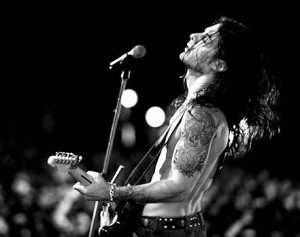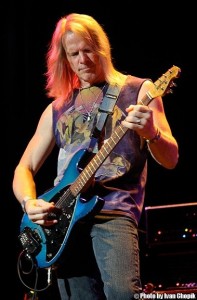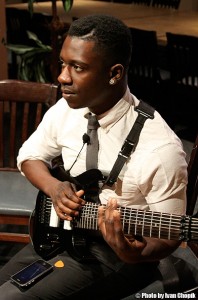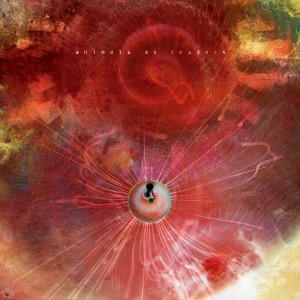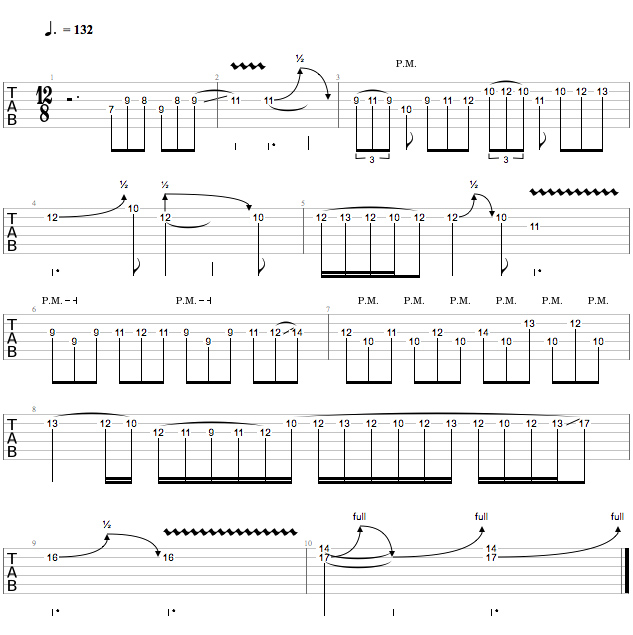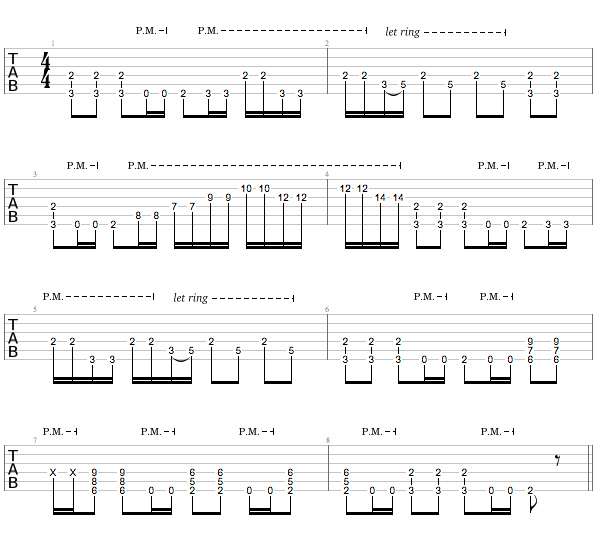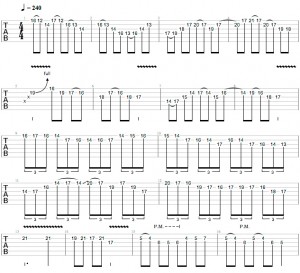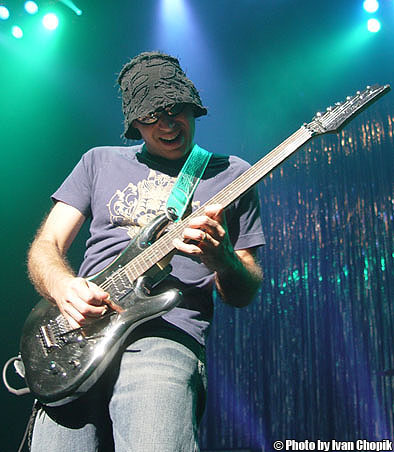 Legendary guitar virtuoso Joe Satriani is one of the most widely respected musicians in the business and an inspiration to many other guitarists. In addition to pursuing his solo career, he’s also been a teacher to people like Steve Vai, Kirk Hammet (Metallica), and jazz fusionist Charlie Hunter. Joe has had an active career for over 20 years now and is still going strong with one of his most solid albums yet released just several weeks ago. Make sure to check out Super Colossal, his latest release, and visit www.joesatriani.com for more info on Joe and his music.
Legendary guitar virtuoso Joe Satriani is one of the most widely respected musicians in the business and an inspiration to many other guitarists. In addition to pursuing his solo career, he’s also been a teacher to people like Steve Vai, Kirk Hammet (Metallica), and jazz fusionist Charlie Hunter. Joe has had an active career for over 20 years now and is still going strong with one of his most solid albums yet released just several weeks ago. Make sure to check out Super Colossal, his latest release, and visit www.joesatriani.com for more info on Joe and his music.
IC: How do you feel about the upcoming tour in support of the new album?
JS: I’m looking forward to it. A lot of new material to bring out on tour, which is always a lot of fun. We get to explore new rhythms and harmonies. Even using some new gear here and there, so I’m looking forward to that.
IC: I understand that you were originally planning to do a live album following the recent G3 tour. What made you change your mind?
JS: I think I was working on the ‘G3 Live in Tokyo’ DVD. It was kind of an obvious realization to come to that the live record had already been done. It was hard for me to look at myself on a screen for hours and hours a day, going over the editing of the DVD performance. So I’m looking at it and I’m thinking, ‘Why would I go and do this all over again if I’ve been doing this for 15 months?’ I thought what I would need is a vacation and a way of sort of recharging.
And that’s what I did and after coming back after a little road trip in Italy, I decided what I really wanted to do was get into a studio by myself and to really try to record things that I felt like listening to and to come up with a different road map for telling musical stories with these instrumentals. And so obviously that meant a studio album and more of a solo artist kind of vibe on the record. I knew that I was going to be playing bass and keyboards and most of the guitars and arranging before bringing any other people into the project
IC: Super Colossal is very groove-heavy and melodic record. What was your approach to writing on this album?
JS: Well, the funny part about sitting down and writing for me is that I have very little control over what I write. I just kind of hope and pray that I get inspired and that when the inspiration comes, I follow it with all of the training that I’ve had to make sure that it doesn’t just evaporate. And then I sit back and I go ‘Well, that’s interesting. Didn’t know I was going to write that!’ I try to write maybe upwards of 20 or 30 pieces and then I start to look at it, like from the outside looking in and saying ‘What songs work together?’ They may be of opposite styles, but they might have something about them that complements them, having them in one collection.
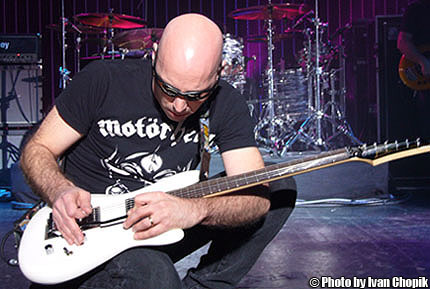 And then I also look for things that I just think are pretty challenging, things that put me in a place I perhaps haven’t been before. I tend to lean towards that a lot. Rather than find things that are similar to the last ten albums, I’m looking for something that’s really different from all that. It could be the way the harmony is set up or the type of groove or maybe the idea I have, that I can have no rhythm guitars and just harmonics on lead guitars. It’s a little thing that sort of strikes me as instinct and I’ll go forward with it in that direction and then don’t sort of try to pre-judge what I’m doing. I just try to record everything and then sit back and see if it’s something that I think has a lot of artistic merit and is truthful to my current feeling. I weigh all those things in and then start to finally get the list down to about 16, 15 songs.
And then I also look for things that I just think are pretty challenging, things that put me in a place I perhaps haven’t been before. I tend to lean towards that a lot. Rather than find things that are similar to the last ten albums, I’m looking for something that’s really different from all that. It could be the way the harmony is set up or the type of groove or maybe the idea I have, that I can have no rhythm guitars and just harmonics on lead guitars. It’s a little thing that sort of strikes me as instinct and I’ll go forward with it in that direction and then don’t sort of try to pre-judge what I’m doing. I just try to record everything and then sit back and see if it’s something that I think has a lot of artistic merit and is truthful to my current feeling. I weigh all those things in and then start to finally get the list down to about 16, 15 songs.
IC: You mentioned that you support your inspiration with all the training that you’ve had to help you write your songs. What is your background in music education?
JS: I started studying drums at 9 years of age. I studied for about two years, maybe a little more, had a private teacher growing up in Long Island, New York … so I learned how to read and write drums and play early rock n’ roll beats and stuff like that. But ever since about 12 years of age I could feel that I wasn’t as coordinated as I thought I should be. I took a break from playing the drums seriously and then during that period was getting into a lot of… rock, disco, R n’B, funk, blues all that…. Hendrix, Cream, and Led Zeppelin and eventually Deep Purple and Black Sabbath. These are the bands that I came of age with. I switched to guitar at age 14, mainly just learning out of books.
During that period I was going to Carl Place High School, same high school that Steve Vai went to, and we both had this really amazing teacher, Bill Westcott. Bill ran a music theory class that we took and it was so thorough …and then that last year he came up with an advanced music theory class. So I wound up taking about two and a half years of theory from him at school. And it was so complete that it pretty much made a university education kind of useless. By the time I was 17 I was already doing road trips for concerts. I was out there being a professional musician. About a year after that I took some lessons from bebop legend Lennie Tristano. I was only able to hang out with him for about 2 or 3 months before I had to go on another tour and after that I’ve been on my own with all the stuff I learned from both Bill Westcott and him. And Lennie’s lessons were just fantastic, definitely a foundation of my musicianship.
Also I forgot to mention, I was accepted at Berklee College of Music. Actually I was hoping to go to Julliard, and I was not accepted at Julliard… I was rather crushed. And I was accepted at Berklee and went up to there and I thought ‘Man, these people up here really party to hard for me.’ (laughs) It was so crazy up there and I thought ‘How am I ever gonna learn?’ Although I was an early heavy-metal playing guitar playerI just felt like I needed a little bit more peace and quiet, so I wound up not taking advantage of being accepted at Berklee.
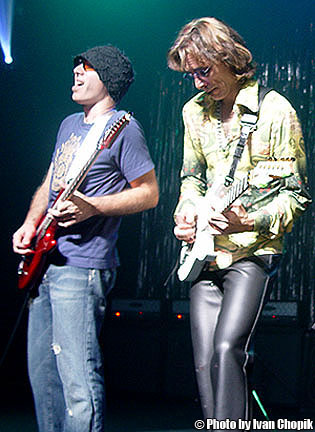
Joe jammin’ with Steve Vai at G3 2003
IC: Did you inspire Steve Vai to apply to and attend Berklee later on?
JS: Yeah, I mean that was the thing to do. It has been a cool school to go to for any aspiring musician, especially for guitar players. …Berklee was the only school to consider for any modern-minded guitar players.
IC: I really dig the tone and the overall production on this Super Colossal. What kind of gear do you use nowadays?
JS: I’ve got a ProTools HD system at my home studio. I went out of my way this time to make sure that the signal path was just really sweet sounding and harmonically rich. I started out making sure I could capture what I felt were the best parts of the Peavey JSX head, which I designed with James Brown, who worked with the Peavey company years ago.
Generally what I do is: I’ve got my guitars, bass, and pedals (or maybe straight into the head), then I use a Palmer speaker simulator. That one goes into a Millennia Media STT-1 recording system, which is basically a mic-pre that’s got some solid-state tube options. Then I’ll run that into, let’s say, a Universal Audio LA-2A, and that’ll go right into ProTools. I tend to be very light when it comes to any EQ or any compression, because in any small home studio, you really don’t know what’s gonna happen with something once you set it next to a drum kit.
I was taught early on by John Cuniberti, who said ‘Go easy on this stuff.’ Using it in your little studio is not really what happens in the big studio, so I used that as my rule, which is to just be very light with this stuff and just make sure you capture the performance happening on the guitar and how you’re playing with the amps. Get the tone with the amp, and then just get it on the drive. With the latest ProTools now recording in 96k there’s tons of headroom, so you can record a far more dynamic and harmonically rich piece of music, than let’s say 5 years ago, which is really great. I would generally lay down tracks with V-Drums and I’m still a crummy drummer so I get down there and I have a great time with the V-Drums and then, thank God, I can correct all the midi information, put it back in time, and sort of get a ball park groove going.
Then I record all the keyboards in the same way. I go back and I can choose different sounds. Sometimes I’ll send midi information to someone like Eric Caudieux, my main producer and editor, and I’ll ask him to find, let’s say a better piano sound or better strings for a particular performance I ’ve done. And then we eventually start to assemble all these tracks and I work on the arrangements at home. Bass is usually the last thing that I’ll put on there, like a serious part. Once again, I’m very cautious how I’m recording it into the music. I’m recording it direct into the Millennia Media, so I’m not using any amp or pre-amp. I usually skip the LA-2A, and just use the Millennia as the sole interface between the bass guitar and ProTools.
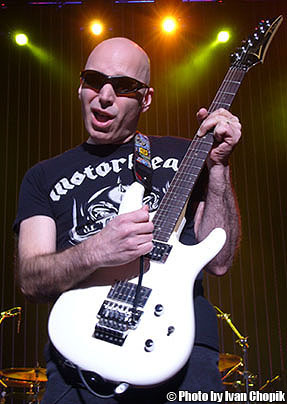 And [I use] hardly any plug-ins. Especially on this record, if I wanted a chorus or flange or something, I would pull out a funky little box and I’d plug it in first on the way to the amp and I would just record it like that. And that way I would make my decision early on, as opposed to sitting there and mixing, going through plug-in after plug-in… so I like the idea of committing early on to the sound that I like.
And [I use] hardly any plug-ins. Especially on this record, if I wanted a chorus or flange or something, I would pull out a funky little box and I’d plug it in first on the way to the amp and I would just record it like that. And that way I would make my decision early on, as opposed to sitting there and mixing, going through plug-in after plug-in… so I like the idea of committing early on to the sound that I like.
We’ve actually moved up to Vancouver, … 9 of the 13 tracks had Jeff Campitelli recording the drums at the Armory Studios in Vancouver. Mike Frasier engineered and co-produced. We also received 4 drum performances from Simon Phillips, which he had recorded in his home studio, out in L.A. about a month prior. And finally we recorded the vocals for the ‘Crowd Chant’ song that’s on the record.
IC: What effect did you use for the main riff of the title track of Super Colossal?
JS: That’s a pedal made by Electro-Harmonix. It’s [called] P.O.G. and I used it in a very subtle way. It’s got a number of sliders that can generate octaves and suboctaves of the original note. It’s a digital effect box. …gotta be very delicate with it. I came up with a sound that I thought would bring to mind a guitar player that was standing 50, 70, 100 feet tall, and walking through your town playing a big, slow riff. (laughs)
IC: You’ve had an active career for over 20 years and just released your tenth studio album, one of your best efforts yet. How do you manage to keep going strong for so many years?
JS: By the grace of God and fans. I’d probably keep going even if I didn’t encounter the success, but the help and support that I get from the fans and from Sony Music is pretty amazing. I know a lot of people are out there bashing the record companies, but Sony has been so helpful to me, because they never get in my way. They always start out by saying ‘What kind of album are you planning this time, Joe?’ which is great. And then once I tell them what I’m doing they say ‘Ok, what do you need? How do we help?’ And their support worldwide is amazing. Whether you’re in India or Bulgaria or South America, they’ve got talented people there, who are promoting, setting up, and facilitating whatever it might be.
Something like me who is out of the mainstream, we do depend on talented people out there, who are agents, managers, and record company people to help get our music out, because we ’re not extroverts. We’re not twenty-year-olds singing and acting in the latest craze that’ll get you right on television. So you can imagine how difficult it is for them to market something like me. And I said before, I’d be doing this even if I didn’t have the success, but the success really is due to the fans and all of this industry that helps me out.
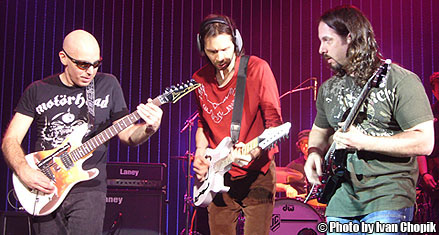
Joe jammin’ with Paul Gilbert and John Petrucci at G3 2007
IC: Do you believe that there’s a change of trend that’s occurring within the industry concerning guitar players? For instance, over the past years magazines like ‘Guitar World’ and ‘GuitarOne’ would to a great extent feature mainstream acts, whereas now more and more we get to see a much greater focus on musicianship. Recent covers of these magazines featured artists like yourself, Buckethead, and Yngwie Malmsteen, for example.
JS: Yeah, I would say that. I recently did a week of in-store appearances from Seattle all the way down to Southern California and Arizona and a large part of the audience were young guitar players ranging from 9 years old to 16. And I hadn’t seen that for at least 10 years, where there was just a lull for a while, where the audience was either not playing or they were an older audience. Now there seems to be this rebirth of young players who really want to do something with the instrument, they wanna get in there and create something new. So I think we’re at the beginning of a kind of new push from out there and people [want] to take control of the guitar again and try to do something interesting with it. I think if you’re 14 years old and you’re playing guitar, this is a really good time.
IC: What kinds of things inspire you to create music nowadays?
JS: I get inspired by everyday life. There’s certainly enough horror and tragedy out there to break your heart … but I’m kind of an optimist, so I tend to concentrate on all the good things that happen in life ’s what keeps me going.
IC: Is there any advice that you can give to aspiring musicians?
JS: Well, I think the obvious stuff is still the most important, which is you’ve gotta know all the notes on your guitar, you’ve got to know all the scales, (you really have to know all the scales), you have to know all the chords and make sure you do that stuff as much as possible.

Ivan Chopik with Joe Satriani in 2007
Focus on putting more time into playing things right than playing things wrong. What I mean is that when you practice, don’t spend hours and hours pushing yourself into areas where there’s constant failure. Spend less time on that part of practicing. Slow it down so that every time you play guitar, there’s a larger percentage of time of you actually playing it right, and less playing it wrong. And so you build a foundation of achievement rather than non-achievement.
And then do whatever you can do to play with people; one-on-one, three people, four people, whatever it is and get into making music for other people, because that’s really what we do. We’re musicians. We make music for people to enjoy, or to shock them, or for some reason. But the main thing is that you have to gain experience playing with and for people, that’s so important. So that’s my advice!



